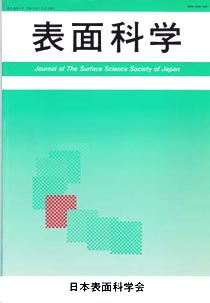All issues

Successor
Volume 23, Issue 12
Displaying 1-7 of 7 articles from this issue
- |<
- <
- 1
- >
- >|
Preface
-
Masaru TSUKADAArticle type: Preface
2002Volume 23Issue 12 Pages 735
Published: December 10, 2002
Released on J-STAGE: October 09, 2008
JOURNAL FREE ACCESSDownload PDF (349K)
Note
-
Zhangping LI, Kichinosuke HIROKAWAArticle type: Note
2002Volume 23Issue 12 Pages 736-739
Published: December 10, 2002
Released on J-STAGE: October 09, 2008
JOURNAL FREE ACCESSBehavior of water on oxide surfaces during the primary ion irradiation in terms of chemical reaction was taken into consideration to infer the appearance regularity of fragment pattern from oxides in Ga+ ion TOF-SIMS. In these cases, hydrogen atoms in fragment ions may originate from the water dropped us great hints.View full abstractDownload PDF (270K)
Current Topics
-
Shuji HASEGAWA, Ichiro SHIRAKI, Fuhito TANABE, Rei HOBARA, Taizo KANAG ...Article type: Current Topic
2002Volume 23Issue 12 Pages 740-752
Published: December 10, 2002
Released on J-STAGE: October 09, 2008
JOURNAL FREE ACCESSFor in-situ measurements of local electrical conductivity of well-defined crystal surfaces in ultrahigh vacuum, we have developed two kinds of microscopic four-point probe methods. One is a ‘four-tip STM prober’, in which independently driven four tips of scanning tunneling microscope (STM) are used for four-point probe conductivity measurements, whose probe spacing can be changed from 0.5 μm to 1 mm. The other one is monolithic micro-four-point probes, fabricated on silicon chips, whose probe spacing is fixed around several μm. These probes are installed in scanning-electron-microscopy/electron-diffraction chambers, in which the structures of sample surfaces and probe positions are in situ observed. The probe can be positioned precisely on aimed areas on the sample with aid of piezo-actuators. With these machines, the surface sensitivity in conductivity measurements has been greatly enhanced compared with macroscopic four-point probe method. Then surface-state conductivity and influence of atomic steps upon conductivity can be directly measured.View full abstractDownload PDF (4653K) -
Shin-ichiro TANAKA, Kazuhiko MASEArticle type: Current Topic
2002Volume 23Issue 12 Pages 753-758
Published: December 10, 2002
Released on J-STAGE: October 09, 2008
JOURNAL FREE ACCESSThe core-level-excitation-induced ion desorption from surface is investigated. Two studies using electron-ion coincidence spectroscopy are shown. On Si(100)/H2O surface, it is shown that ion desorption is mainly induced by the shake-up/off excitation accompanying the Auger decay when the photon energy is near the O1s threshold. At a photon energy higher than the shake-up threshold, most of ions desorb resulting from the shake-up excitation accompanying the core-excitation. In both cases, the desorption is induced by the multi-hole final state. On ice surface, the kinetic energy of O1s photoelectrons gives the highest coincidence yield of H+ desorption is shifted by about −0.7 eV compared to the O1s peak observed in the conventional core-level photoelectron spectroscopy. It is ascribed to a core-level shift in the O1s level from which hydrogen ions desorb.View full abstractDownload PDF (957K) -
—Hydrogen-Surfactant Mediated Epitaxy of Ge on Si(001)—Mitsuhiro KATAYAMA, Toshiaki FUJINO, Kenjiro OURAArticle type: Current Topic
2002Volume 23Issue 12 Pages 759-766
Published: December 10, 2002
Released on J-STAGE: October 09, 2008
JOURNAL FREE ACCESSWe have recently developed coaxial impact-collision ion scattering spectroscopy (CAICISS) and time-of-flight elastic recoil detection analysis (TOF-ERDA) operable in a gas phase atmosphere in the pressure regime up to 10−4 Torr. This apparatus was applied to real-time monitoring of the growth of Ge on Si(001) with dynamically supplied atomic hydrogen (H) as a surfactant. The Ge thin film growth on a H-terminated Si(001) surface was also investigated. On this basis, it has been revealed that (1) a submonolayer of H atoms readily acts as a surfactant, (2) the intermixing of Ge and Si occurs at the initial stage of Ge growth in the presence of H-surfactant, and (3) beyond optimal H coverage of about 0.6 monolayer, surface roughening occurs even though a monohydride phase is maintained at the growth front.View full abstractDownload PDF (1502K) -
Time-resolved Core-level Photoelectron Spectroscopy for Analyzing Phenomena of Semiconductor SurfaceFumihiko MAEDA, Yoshio WATANABEArticle type: Current Topic
2002Volume 23Issue 12 Pages 767-774
Published: December 10, 2002
Released on J-STAGE: October 09, 2008
JOURNAL FREE ACCESSWe describe the development of an equipment which can be employed for examining various surface phenomena in real-time by performing time-resolved core-level photoelectron spectroscopy. We demonstrate this unique capability by examining the desorption of Sb atoms occurring from GaSb(001) as well as Sb/GaAs(001) in the temperature range of 440oC∼580oC, which is the usual growth temperature. The time dependence of core-level photoelectron spectra revealed that the activation energy for Sb desorption varies from 0.7 eV to 2.5 eV due to the difference in local bonding structures. In addition, experiments on alternating growth of GaAs suggest that there are two Ga adsorption sites, the occupation of which is dependent on the Ga coverages. This finding is in agreement with theoretical studies. These results demonstrate the potential of the technique to elucidate the surface process by real-time analysis.View full abstractDownload PDF (1592K)
News & Trends
-
Article type: News & Trends
2002Volume 23Issue 12 Pages 775
Published: November 10, 2002
Released on J-STAGE: October 09, 2008
JOURNAL FREE ACCESSDownload PDF (146K)
- |<
- <
- 1
- >
- >|